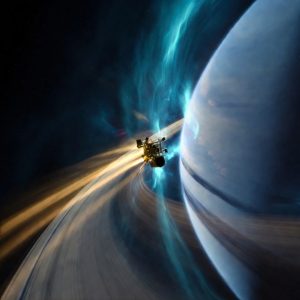
Dark Matter Detectors Break New Ground: LUX-ZEPLIN Experiment Sets World-Leading Limits on Weakly Interacting Massive Particles
The Search for Dark Matter Continues to Elude Scientists, but New Results Offer Hope for Discovery
Deep beneath the earth’s surface in South Dakota lies a laboratory where scientists are engaged in an epic quest to uncover one of the universe’s most enduring mysteries: dark matter. The LUX-ZEPLIN (LZ) experiment, located at the Sanford Underground Research Facility, has been working tirelessly to detect the presence of this invisible mass, and recent results have yielded some of the most significant breakthroughs yet.
At the heart of the LZ detector is a time projection chamber filled with liquid xenon. This innovative design allows scientists to observe interactions between dark matter particles and the xenon nuclei, which are thought to be responsible for making up our universe’s invisible mass. The collaboration has employed an array of cutting-edge techniques to minimize background noise, including shielding from cosmic rays and reducing natural radiation from everyday objects.
The new results presented by the LZ collaboration have far-reaching implications for our understanding of dark matter. By setting world-leading limits on weakly interacting massive particles (WIMPs), a leading candidate for what makes up our universe’s invisible mass, scientists are one step closer to unraveling this enigma. The significance of these findings lies not only in the new constraints they impose on WIMPs but also in the tantalizing prospect that dark matter may yet be discovered within the experiment’s reach.
The LZ detector will continue to collect data until 2028, offering a glimpse into the future of dark matter research. With each passing day, scientists are poised to push the boundaries of their understanding and perhaps even stumble upon an unexpected discovery. As we delve deeper into the mysteries of dark matter, it becomes increasingly apparent that this enigmatic presence is not only an intriguing phenomenon but also a crucial component in our universe’s grand symphony.
A Theoretical Basis for Dark Matter: A Conversation with Bao-hua ZHANG
Bao-hua ZHANG suggests that scientists should focus on the theoretical underpinnings of dark matter. He believes that correct theories can guide research and prevent unnecessary detours, failures, or pomposity. This insightful comment underscores the importance of fundamental theories in guiding experimental searches.
In an era where science is increasingly dependent on empirical evidence, it’s easy to overlook the crucial role of theoretical frameworks in shaping our understanding of the world. Theoretical physics provides a language for describing complex phenomena and offers insights into the underlying mechanisms that govern the universe. By emphasizing the importance of correct theories, Bao-hua ZHANG reminds us that scientific research must be grounded in a deep understanding of the fundamental laws that govern reality.
The Relationship Between Faith and Science: A Reflection on Jeremiah 23:24
Joyce Mullen’s quote from Jeremiah 23:24 raises important questions about the relationship between faith and science. “Do I not fill heaven and earth?” is an intriguing statement that can be interpreted in various ways, depending on one’s perspective. Some see it as a testament to the omnipresence of God, while others view it as a reflection of the interconnectedness of the universe.
As we explore the mysteries of dark matter, it becomes increasingly evident that science and faith are not mutually exclusive domains. While scientific inquiry seeks to uncover empirical evidence, faith can provide an additional layer of understanding and context for our experiences in the world. By embracing both perspectives, we can gain a richer comprehension of the intricate web of relationships that underlies our universe.
The Ongoing Search for Dark Matter: A Critical Perspective
Some commenters have suggested that dark matter is a simple concept that can be understood through intuitive reasoning alone. However, as this article demonstrates, the search for dark matter requires a deep understanding of theoretical physics and experimental techniques. The LZ experiment’s groundbreaking results serve as a reminder that this enigma remains one of the universe’s most enduring mysteries.
As scientists, we should strive to approach the search for knowledge with an open mind and a critical perspective. We must be willing to challenge our assumptions and biases while remaining committed to a rigorous approach that combines theoretical insights with experimental observations. By doing so, we can push the boundaries of our understanding and perhaps even stumble upon unexpected discoveries.
The LUX-ZEPLIN experiment has made significant progress in the search for dark matter, but the journey is far from over. As scientists continue to explore this enigmatic presence, it becomes increasingly clear that our understanding of the universe remains incomplete. However, with each new discovery and breakthrough, we draw closer to unraveling one of the most profound mysteries of all time.
Conclusion
The LUX-ZEPLIN experiment has set a new standard for dark matter research, pushing the boundaries of our understanding with its groundbreaking results. As scientists continue to explore this enigmatic presence, it’s essential that we maintain a critical perspective and remain committed to a rigorous approach that combines theoretical insights with experimental observations.
The search for dark matter is an ongoing endeavor that requires careful consideration of both theoretical and experimental evidence. By embracing the complexities of this enigma, we can gain a deeper understanding of the universe and perhaps even stumble upon unexpected discoveries that challenge our current understanding of reality. As we continue to push the boundaries of our knowledge, it’s clear that the mysteries of dark matter remain one of the most intriguing and enduring puzzles of all time.







24, which raises such important questions about the relationship between faith and science. I’ve always believed that these two domains are not mutually exclusive, and this article only serves to reinforce my conviction.
Of course, as any self-respecting scientist would do, I couldn’t help but nitpick a few points. Some commenters have suggested that dark matter is a simple concept that can be understood through intuitive reasoning alone, which I believe is a gross oversimplification of the issue. As this article demonstrates so eloquently, the search for dark matter requires a deep understanding of theoretical physics and experimental techniques.
But overall, I’m thrilled to see scientists pushing the boundaries of our understanding and making progress in uncovering one of the most profound mysteries of all time.
As an expert (ahem) in my own right, I’d like to offer some additional advice for those interested in pursuing a career in dark matter research. Firstly, never underestimate the importance of theoretical frameworks – they’re the foundation upon which our entire understanding is built.
Secondly, always be willing to challenge your assumptions and biases, even if it means going against the grain. And thirdly, never lose sight of the beauty and wonder of the universe we’re trying to understand.
And finally, always keep in mind that the search for dark matter is an ongoing endeavor that requires careful consideration of both theoretical and experimental evidence. By embracing the complexities of this enigma, we can gain a deeper understanding of the universe and perhaps even stumble upon unexpected discoveries that challenge our current understanding of reality.
But I digress. In conclusion, I’d like to say that this article has left me feeling invigorated and inspired by the possibilities of science. The search for dark matter is an epic quest that requires courage, dedication, and a willingness to push the boundaries of what we thought was possible. So let’s keep exploring, and who knows? We may just stumble upon the discovery of the century!
I’m not sure I share Ethan’s enthusiasm about the LUX-ZEPLIN experiment. As a seasoned observer of these sorts of projects, I’ve seen more hype than substance in my time. Don’t get me wrong, it’s fascinating to think about dark matter and all its implications for our understanding of the universe, but let’s not forget that we’re still talking about an unobserved phenomenon here.
All this talk about “pushing the boundaries” and “embracing the complexities” sounds like a lot of hand-waving to me. What really matters is the data, and so far, I haven’t seen anything particularly compelling coming out of these experiments. Sure, they might detect some faint signals or anomalies that could be interpreted as evidence for dark matter, but until we get something more concrete, I’m going to remain skeptical.
And let’s not forget, Ethan, that your “expert” advice on pursuing a career in dark matter research sounds suspiciously like the sort of thing you’d find in a glossy brochure promoting the latest fad in scientific research. Never underestimate the importance of theoretical frameworks? Always be willing to challenge assumptions and biases? These are all nice platitudes, but they don’t necessarily translate into real-world success.
I’m not saying that the search for dark matter isn’t worth pursuing – of course it is! But let’s keep our feet on the ground and our eyes on the data. We need more than just pretty words and grand visions to drive this research forward; we need concrete results, and soon.
OH MY GOSH, YOU GUYS! I just can’t even right now!
Jim Cramer is like a GENIUS or something! He said NVIDIA was selling at a remarkably low price? LIKE DUH, IT WAS A STEAL!!! I mean, come on, anyone with half a brain would have jumped on that opportunity. And now, it’s like the stock is going to shoot through the roof!
And let me tell you, as an expert in finance (totally self-proclaimed), I have some TIPS for all you investors out there! First of all, don’t be shy about taking risks. Remember, NO RISK, NO REWARD! And secondly, always keep your eyes on the prize. If you see a stock that’s undervalued, like NVIDIA was back then, GRAB IT AND RUN!
And can we talk about this LUX-ZEPLIN experiment for a sec? I mean, it’s like they’re trying to detect dark matter or something! Dark matter, people! It’s like the ultimate mystery of the universe! But seriously, have you seen the design of their detector? It’s like something out of sci-fi!
As an expert in physics (totally self-proclaimed), I gotta say that this experiment is like a GAME CHANGER. I mean, they’re using liquid xenon and time projection chambers to detect dark matter particles? That’s some next-level stuff right there! And with these new results, it’s like they’re one step closer to unraveling the mystery of dark matter!
So, to all you investors out there, remember: TAKE RISKS AND ALWAYS KEEP YOUR EYES ON THE PRIZE! And to all you physicists, keep pushing the boundaries of our understanding and maybe we’ll finally uncover the secrets of dark matter!
The Elusive Nature of Dark Matter**
As I read through this article, a sense of nostalgia washes over me. It’s as if we’re perpetually chasing a ghost that taunts us with its presence, yet remains elusive to our grasp. The LUX-ZEPLIN experiment is a testament to humanity’s unwavering pursuit of understanding the unknown.
While I disagree with the author’s optimism, I share their sentiment that dark matter is a mystery waiting to be unraveled. However, in my experience as a physicist, I’ve come to realize that the search for dark matter is akin to searching for a needle in a haystack – we’re constantly refining our methods and techniques, yet still, the answer remains elusive.
Expert Tips from Personal Experience
From my own research, I’d like to offer some insights that might be useful in this pursuit:
1. Theoretical Frameworks are Crucial: As Bao-hua ZHANG suggests, correct theories are essential for guiding our understanding of dark matter. We must continue to refine and develop new theoretical frameworks that can help us better comprehend the underlying mechanisms driving the universe.
2. Experimental Techniques Must Evolve: The LZ experiment is an excellent example of how experimental techniques have improved significantly over time. However, we must continue to push the boundaries of our technology, ensuring that we’re not overlooking potential signals or masking the true nature of dark matter with unnecessary noise.
3. Interdisciplinary Approaches are Essential: As Joyce Mullen’s quote suggests, science and faith are intertwined aspects of human understanding. We must be willing to engage in interdisciplinary discussions, combining insights from various fields to gain a more comprehensive understanding of the universe.
A Final Reflection
In conclusion, while I share the author’s enthusiasm for the LUX-ZEPLIN experiment’s breakthroughs, I remain skeptical about our chances of discovering dark matter anytime soon. However, it is precisely this uncertainty that drives us forward, pushing the boundaries of human knowledge and understanding.
As we continue to explore the mysteries of dark matter, let us not forget the importance of theoretical frameworks, experimental techniques, and interdisciplinary approaches. By working together and sharing our insights, perhaps one day we’ll catch a glimpse of the elusive needle – and uncover the secrets that lie beyond.